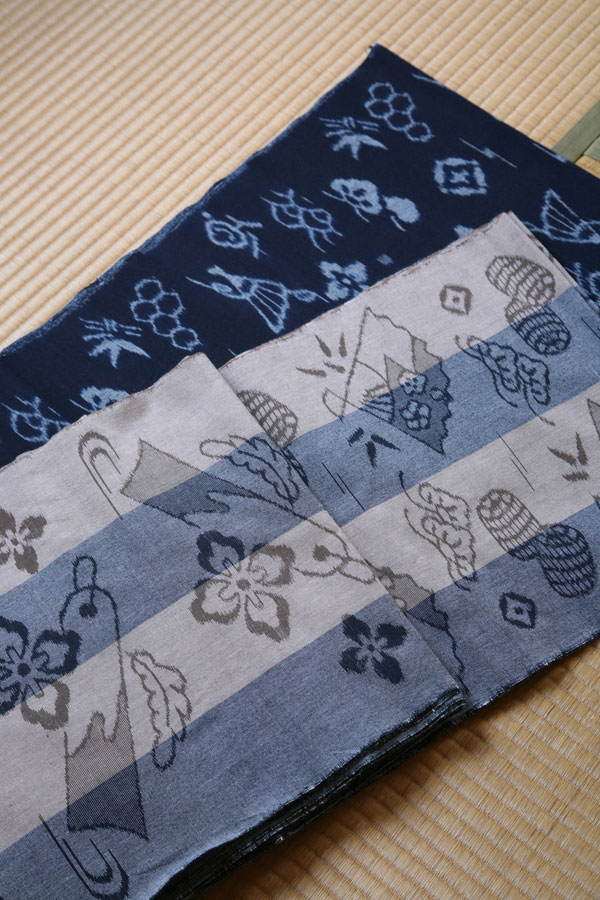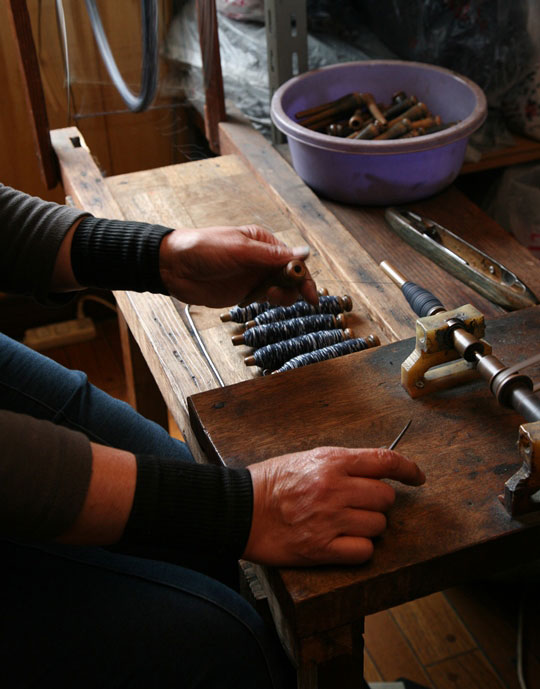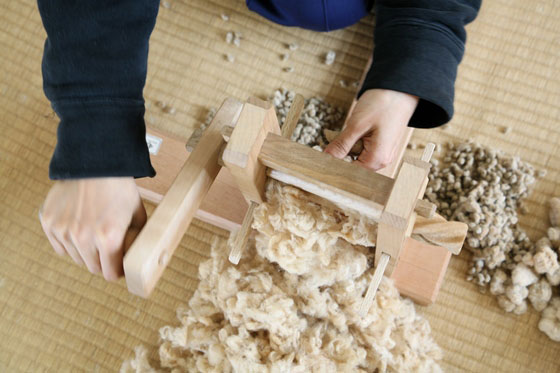
- Woven textiles
- Tottori
Yumihama traditional resist-dyed textiles Yumihama gasuri
The long and honorable history of Tottori
in a traditional craft
Description
What is Yumihama traditional resist-dyed textiles ?
Yumihama traditional resist-dyed textiles (called Yumihama gasuri in Japanese) is produced near the city of Sakaiminato, Tottori prefecture. The name comes from Yumigahama, which is a curved shore that stretches for more than twenty kilometers (about twelve and a half miles) between the cities of Yonago and Sakaiminato. This craft is woven with kasuri* threads which are dyed before weaving. The main color is navy blue while the patterns are created with white threads that have an elegant hint of a navy blue tone. Yumihama gasuri was popular with residents of the region because the coarse fabric and plain patterns made it an ideal textile for local farmers who needed clothing that was easy to wear and wash. In recent years, the use of the textile has become more diversified as familiarity with it has increased from farmers to the rest of the populace. Various items useful for daily life are made with Yumihama gasuri including bags, coasters, table linen, and coin purses.
* A kasuri or ikat pattern is precise patterning and images that result from a technique of wrapping fibers with thread in order to dye specific parts of fabric.
History

The history of Yumihama traditional resist-dyed textiles dates back to the year 1751. At that point, the technique for weaving kasuri textiles had developed and become well-known in the San’in region (Tottori, Shimane prefecture, and northern Yamaguchi prefectures). Many kinds of kasuri textiles were produced in the area such as Hirose gasuri, Yumihama gasuri, and Kurayoshi kasuri. Among them, Yumihama gasuri was the most popular and valued among the general public, especially farmers. In fact, the wives of these farmers pioneered this textile. They normally worked on producing plain cotton textiles and started making this craft as a side business to make their work clothes, best clothes, and covers for futon (Japanese bedding).
The production of Yumihama gasuri peaked between the Edo period (1603–1868) and the Taisho period (1912-1926) as Tottori prefecture became the third largest in terms of kasuri textile production in Japan. In 1975, Yumihama gasuri was designated as an intangible cultural asset and many organizations and workshops have been established nationwide to preserve the Kasuri production.
General Production Process

- 1. Sorting the weft threads
The number of weft threads (perpendicular threads) are put together with a standard thread to match the requirements for weaving the textile. The threads are pulled out from cotton and spun by hand carefully using a spinning wheel. The threads vary depending on how the threads are spun therefore an experienced artisan is necessary to spin the threads correctly.
- 2. Designing
This is an important process to decide the design. The full-scale patterns are drawn on paper so they must be very precise. Designs tends to express the wish for the sound health of one's family or for a good harvest.
- 3. Making a paper pattern
When there are many textiles with the same kasuri patterns to be produced, a paper pattern is made for all of them and cut from tanned paper.
- 4. Making the foundation threads
The weaving threads are an important foundation for kasuri designs. If the threads become stretched, the patterns are ruined. Therefore, the key point in this step is to properly affix the threads to a frame so they are not stretched unnecessarily.
- 5. Winding the threads
The threads are wound around a drafting table. They have to be wound with the same density along the width of the design. It is important to have this process done by an experienced artisan.
- 6. Marking with ink
The threads wound in the previous step are marked with ink based off the paper pattern.
- 7. Tying the weft threads
The weft threads that were marked in the previous process are tied where it is marked.
- 8. Dyeing the threads
The threads are dyed indigo blue, which is a distinctive feature of this craft, with a specially made chemical dye. One way to make the mixture is to use a scarce form indigo, which has been fermented, and mix it with a chemical dye while another method is to mix the chemical dye and lime. These dyes are used to bring out the unique texture of this craft.
- 9. Releasing the tied parts of threads
When the threads are dyed, the tied parts are untied. After that, they are washed and dried to get rid of the impurities.
- 10. Sorting of the weft threads
The weft threads are sorted and wound around the frame.
- 11. Winding the weft threads
The weft threads are sorted to the length that is required for weaving the textile. Then, the threads are wound carefully. Preparation before weaving is completed in this process and the weaver starts weaving using both the weft (perpendicular) and warp (parallel) threads.
Where to Buy & More Information
Yumihama Gasuri Denshokan

-
Address
-
Tel.+81-859-45-0926
-
ClosedSaturdays, Sundays, national holidays, around the New Year
-
Business Hours8:30am to 5:15pm
See more Woven textiles
- Nishijin brocade
- Yuki tsumugi silk
- Kurume traditional resist-dyed textiles
- Ojiya chijimi textiles
- Hakata brocade
- Ushikubi tsumugi silk
- Chichibu-meisen silk
- Miyako ramie textile
- Shiozawa tsumugi silk
- Kumejima tsumugi silk
- Omi ramie cloth
- Ryukyu traditional resist-dyed textiles
- Kiryu brocade
- Murayama-oshima tsumugi silk
- Yumihama traditional resist-dyed textiles
- Chibana-hanaori textiles
- Hon-shiozawa silk
- Oitama tsumugi silk
- Ojiya tsumugi silk
- Yaeyama cotton cloth
- Yaeyama ramie cloth
- Honba oshima tsumugi silk
- Shinshu tsumugi silk
- Shuri brocade
- Tama brocade
- Yomitanzan-hanaori textiles
- Isesaki traditional resist-dyed textiles
- Hachio island silk
- Nibutani bark cloth
- Uetsu tilia bark cloth
- Awa-shijira cotton cloth
- Kijoka banana fiber cloth
- Tokamachi traditional resist-dyed textiles
- Tokamachi akashi chijimi textiles
- Yonaguni brocade
- Yuntanza minsa
- Flower pattern textiles
- Oku-Aizu Showa Karamushi Textiles































































































































































































































































































